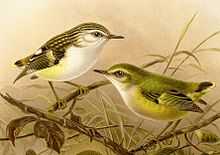Rifleman (bird)
| Rifleman | |
|---|---|
 | |
| Female on left, male on right. | |
| Conservation status | |
| Scientific classification | |
| Kingdom: | Animalia |
| Phylum: | Chordata |
| Class: | Aves |
| Order: | Passeriformes |
| Suborder: | Acanthisitti |
| Family: | Acanthisittidae |
| Genus: | Acanthisitta Lafresnaye, 1842 |
| Species: | A. chloris |
| Binomial name | |
| Acanthisitta chloris Sparrman, 1787 | |
| Subspecies | |
|
Acanthisitta chloris chloris | |
The Rifleman (Acanthisitta chloris) (Māori: Tītipounamu) is a small insectivorous passerine bird that is endemic to New Zealand. It belongs to the Acanthisittidae family, also known as the New Zealand wrens, of which it is one of only two surviving species. The Rifleman resembles a wren in form but is not related to the family of true wrens, Troglodytidae, nor the fairy-wrens of Australia.
The Rifleman is named after a colonial New Zealand regiment because its plumage drew similarities with the military uniform of a rifleman.[2]
Description
The Rifleman is New Zealand's smallest endemic bird, with fully grown adults reaching around 8 cm. The male Rifleman is bright green on the dorsal side while the female is of a more somber brownish tone and her head and back are flecked with ochre. Male birds typically weigh around 6 g, females 7 g. Both birds are white on their under surfaces and have white eyebrow stripes. They have short, rounded wings, a very short tail, and a long thin awl-like bill which is slightly upturned for insertion into cracks. The Rifleman flies quickly with a wing beat producing a characteristic humming sound like a humming bird.
Distribution and habitat

The true habitat of this bird is thinly wooded forests, but other similar New Zealand species live near rocky outcrops. The Rifleman is the most widespread species of acanthisittids in the two main islands of New Zealand. However the bird occurs only rarely in latitudes north of Te Aroha. The North Island subspecies, granti, occurs mainly in lowland tawa forest, while the South Island subspecies, chloris, is found in high altitude beech forest or lowland areas forested with podocarp.
Behaviour
Diet
The Rifleman is insectivorous and searches for maggots and small insects on tree trunks and among leaf litter on the forest floor. The Rifleman searches for food in a similar way to the Treecreeper. The bird begins its search from the base of a tree and climbs up it progressively, spiralling up around the trunk. Upon finishing its search of a particular tree, the bird glides to the foot of a neighbouring tree and begins its search again.
Range
The Rifleman covers the same or similar territory everyday, which a male/female pair defend. They can only fly short distances, meaning they're unlikely to cross open areas.[3] The bird was once common across New Zealand, but the fragmentation of forests from land development has meant less habitat and more isolated populations.[4]
Reproduction
Acanthisittids build their nest in rock fissues, holes in tree trunks, or even in cavities in the ground. The nest entrance is often so narrow that the bird struggles to get inside. The nest most commonly has a dome shape and is finely interwoven with blades of grass, down feathers and other kinds of light material. Brooding lasts 13–15 days with the female laying 4-5 eggs. Two broods per year are common.
Song
A. chloris has a high-pitched call that can be out of the range of people's hearing.[3]
Cultural references
The Rifleman was pictured on the reverse side of the New Zealand $2 note from 1967 until the note was phased out in 1991.[2]
References
- ↑ BirdLife International (2012). "Acanthisitta chloris". IUCN Red List of Threatened Species. Version 2013.2. International Union for Conservation of Nature. Retrieved 26 November 2013.
- ↑ 2.0 2.1 "The history of bank notes in New Zealand". Reserve Bank of New Zealand. Retrieved 4 February 2012.
- ↑ 3.0 3.1 "Story: Land birds – overview". Retrieved 4 February 2013.
- ↑ "Story: Small forest birds - Page 2 – Riflemen". Te Ara - the Encyclopedia of New Zealand. Retrieved 4 February 2013.
- Buller, W.L. Birds of New Zealand, 1888.
- Oliver, W.R.B. New Zealand Birds, 1955.
